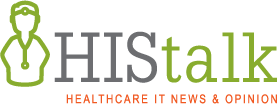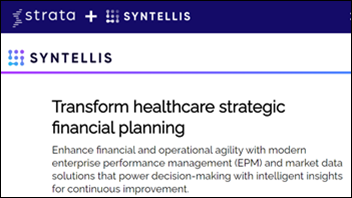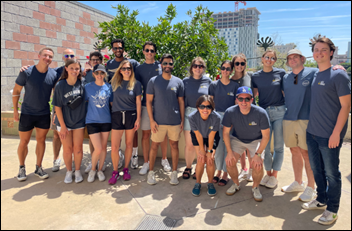HIStalk Interviews Patty Riskind, CEO, Orbita
Patty Riskind, MBA is CEO of Orbita of Boston, MA.

Tell me about yourself and the company.
I’ve worked in healthcare data analytics tech for over 30 years, predominantly in the patient engagement and employee engagement side of the industry. I founded a company that was the first electronic survey company in healthcare. At the same time SurveyMonkey was starting, I started a company called PatientImpact, which I ended up selling to Press Ganey, which is the largest patient satisfaction survey company in the US. From there I worked for Qualtrics, which is an experience management company, as the global head of healthcare. I created their healthcare division.
From there, I joined Orbita. Orbita is a conversational AI company. We help use technology to automate workflows. We strive to be the human side, and use conversational AI and generative AI to make it easy for patients to navigate through the healthcare system and alleviate the administrative burden on employees and clinicians. So I moved from measurement of the patient experience now to actually trying to impact the patient experience by making it easier to do business in healthcare.
What components of the digital front door have provided the strongest return on investment, and how do you expect to see that change in the next few years?
The biggest return on investment using a digital front door is, in many cases, twofold. One, if someone goes to a website, they are looking for something. If you make it easy for them to find it, then you have improved that patient experience. Often what people are looking for is ways to schedule an appointment. If you can automate the process of identifying where to go, who to see, and then actually help them execute on that in terms of scheduling, then you are contributing to a better patient experience. You are also driving revenue. That’s an easy measurement to understand the impact that a digital front door can have.
In addition, digital front doors can reduce call volume to call centers. Many health system and medical groups are still dependent on a patient making a phone call. If you can reduce the number of calls that are coming in, call center and front desk staff are less inundated with handling basic questions related to scheduling, where to park, or or how to prepare for the visit.
I see return on investment coming from both a cost reduction as well as revenue generation and reducing the administrative burden of staff. The cost of labor continues to be high in healthcare, and the number of the people that are needed to work in things like call centers as well as administrative roles is still a challenge for many health systems and medical groups.
Search engine companies are trying to figure out when users prefer traditional search versus AI chat. What are the use cases for provider website search and the tools that support it?
We have actually married search with a chat experience. The most common search of hospital and medical group websites are keyword searches. We have married the search capabilities with a conversation. If someone types in, “I’m looking for a foot doctor near me,” we can pick that up and then ask related questions. Are you referring to a podiatrist? When you say “near me,” what is your ZIP code or address? How old are you, so we know if this is specific to pediatric or a geriatric? What kind of physician are you looking for?
We know that about 43% of people who go to a website start with the search bar. We narrow that search by walking folks through the steps to help them find what they are looking for. There’s a real opportunity to take the chatbot out of the bottom right hand corner and instead place it anywhere on a website, including the search bar.
In the pre-cellphone days, consumers would do anything to avoid navigating a phone tree and would instead press random buttons hoping to be transferred to a human. Now they will expend equal energy to avoid talking to a human in favor of pressing phone buttons. How do health systems address those consumer preferences?
You are absolutely right. The Gen Z population doesn’t want to talk on the phone. I’m a Gen Xer and I don’t want to talk on the phone either. People are more comfortable interacting with a chatbot these days, especially with the rise of ChatGPT. There’s a greater understanding and a greater tolerance for interacting with an automated attendant.
But you always need an escape hatch. You always need the ability to escalate to a live person. You can start a digital conversation, but the bot should be smart enough to identify when someone needs to talk to a human being. Either they’re getting frustrated or they are asking questions that require a more hands-on human who can answer the questions or can help that individual.
We build in an escalation to a live agent as part of everything that we do. That’s our recommendation for customers. There’s still the need for human beings. Ideally we remove the mundane or the repetitive type questions that someone s in a call center might get, and instead they get the more complex questions or can talk to those patients who really need to talk to a human being.
One of the advantages we bring, in addition to a digital front door or a Q&A chatbot, is that we have a communications hub that allows a call center agent to have a digital conversation. They can manage up to six conversations at the same time. A consumer might start with a chatbot type of experience and then escalate to a live agent. That live agent gets the transcript of what has been discussed up to that point, and then they can take it on. The content or the knowledge bases that we use to power our automated assistance can be used by the call center agent to answer questions. So when it comes to onboarding new staff and training them, we provide an elegant way to get folks up to speed fast so that they can start taking phone calls. They have the best of both worlds in being able to use technology to deflect those routine phone calls, but also allowing those agents to leverage the technology so that they can answer questions when they are engaging with a person.
To what extent are providers using, or planning to use, AI-powered technologies to triage calls?
They are planning on using it more, because call centers are inundated and there’s not enough staff. They can analyze the types of calls they are getting and deflect the routine questions. We’ve heard that 80% of the calls that come in involve where to park or how to schedule an appointment. It’s the same questions over and over. More providers are going to take advantage of automating the routine questions so that they can leverage the staff that they have in a more effective way.
How are customers using your CallDeflectAI product?
CallDeflectAI does exactly what we have been talking about. Patients or consumers can find information by going to the website and interacting with a chatbot versus having to talk to a human by making that phone call. CallDeflect AI uses generative AI to scrape everything that is on the customer’s website or in manuals. Whatever data that they can provide that will be relevant to what someone will call about or want to talk about. We can ingest that incredibly quickly.
Within a couple of hours, we can stand up a Q&A type chatbot that our client places on their website. It then directs patients, or their call center or automated attendant can say, “Can I transfer you to our website or our digital assistant to answer whatever questions you may have?” It drives folks to find answers in a more convenient and helpful way versus staying on hold or taking up the time of an agent that could be spent differently.
CallDeflectAI has been exciting for us because we have been using generative AI for some time, but this allows us to put it to work really, really quickly. When your call center is inundated, it provides an elegant way to deflect those phone calls.
As health systems expand into multiple states with dozens of hospitals and hundreds of locations, how do they use technology to help patients find the nearest location or first available appointment while enhancing the corporate brand?
You would think they would be taking advantage of it, but there’s relatively slow adoption, partly because healthcare doesn’t always move quickly in terms of adopting new tech. There is fear and concern as it relates to security, and especially with ChatGPT’s hallucinations, there’s a lot of paranoia.
We host on a private cloud. We only reference content that has been validated and authenticated. We are HIPAA and SOC 2 in terms of privacy and security. We can reassure that the content that is referenced is correct and that everything is hosted in a secure and private way.
They then can take advantage of their content that they trust and we can customize to reflect their local environment while maintaining the brand, both from look and feel as well as the content itself. We can reinforce the brand that that organization represents, but also allow for access to local doctors, the local urgent care, or the local resources in a specific community that relate to that individual location.
How has the digital health market changed and what is coming next?
We saw things slow down pretty significantly in 2022, in large part because providers had negative operating margins and the mantra was cut costs and don’t invest. But I’m seeing that loosen up. I’m seeing more curiosity about new tech, as well as more of an appetite to make specific investments. I think we are turning a corner and the market is going to continue to improve over the course of 2023 and into 2024.
It probably will take until 2025 before we start to see anything coming even close to the investment environment that we saw in 2021. We may never get to the go-go days of 2021, where companies that were not making any money got 20 times revenue type valuations. I am not sure we will see that for some time.
Orbita’s goal is to continue to leverage technology, but focus on the problems that we are solving for our customers. We will create solutions and use cases that help address the needs that our clients have, whether that relates to growing revenue or managing costs, leveraging ways to extend the capabilities of their workforce by leveraging automation and technology. We are focused on growing and listening to our customers to meet their needs. Hopefully the market will respond in kind.









































Wait what? "A member of Save Jennie Stuart says that the 194-bed hospital seeks new ownership because of “a recently…